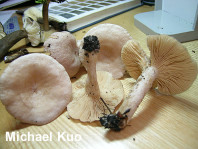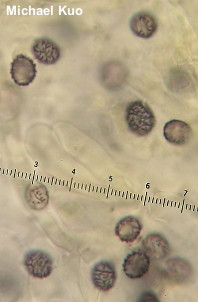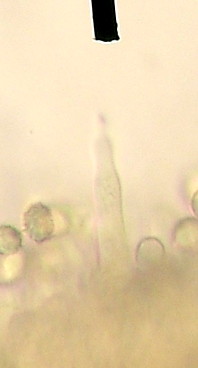| Major Groups > Gilled Mushrooms > Pale-Spored > Lactarius > Lactarius glyciosmus |

|
Lactarius glyciosmus [ Basidiomycota > Russulales > Russulaceae > Lactarius . . . ] by Michael Kuo Lactarius glyciosmus is a drab little mushroom, but two things make it pretty easy to identify: it is mycorrhizal with birch, and it smells like coconuts. On the West Coast Lactarius glyciosmus might be confused with Lactarius cocosiolens, which also smells like coconuts but features a slimy brownish orange cap and appears in coastal, birch-less forests. Whether or not our North American version of Lactarius glyciosmus is the same as the original, European species (first described by Fries in 1818), has not been established. Thanks to the Field Museum of Natural History in Chicago for facilitating study of the Lactarius glyciosmus collection cited below. Description: Ecology: Mycorrhizal with paper birch (possibly also with other birches); also reported with alder; growing alone, scattered, or gregariously; late summer and fall; widely distributed in North America wherever the host trees occur. The illustrated and described collections are from Michigan and Wisconsin. Cap: 2–7 cm; thin and fragile; convex with an inrolled margin when young, becoming shallowly depressed, flat, or shallowly vase-shaped; dry; bald; finely roughened; pinkish buff; sometimes featuring vague concentric zones of color or texture. Gills: Attached to the stem or running down it; close; short-gills frequent; whitish to yellowish; not bruising or discoloring. Stem: 3–7 cm long; up to 8–15 mm thick; more or less equal; dry; without potholes; bald; colored like the cap or paler. Flesh: Insubstantial; pale; not changing when sliced. Milk: White; often scanty; not changing on exposure to air; not staining tissues. Odor and Taste: Odor strongly of coconuts; taste slightly acrid. Spore Print: Cream. Chemical Reactions: KOH yellowish on cap surface. Microscopic Features: Spores 5.5–9 x 5.5–7 µm; broadly ellipsoid to subglobose; ornamentation as thick, amyloid spines and ridges extending 0.5–1 µm high, forming zebroid patterns and partially reticulated areas. Pleuromacrocystidia and cheilomacrocystidia 50–90 x 5–7.5 µm; narrowly fusiform; occasionally developing an apical knob; hyaline to yellowish in KOH; smooth; thin-walled. Pileipellis a cutis; hyaline to yellowish in KOH. REFERENCES: (Fries, 1818) Fries, 1838. (Saccardo, 1887; Hesler & Smith, 1979; Smith, Smith & Weber, 1979; Phillips, 1991/2005; Heilmann-Clausen et al., 1998; Trudell & Ammirati, 2009.) Herb. F. CO220079F. This site contains no information about the edibility or toxicity of mushrooms. |
© MushroomExpert.Com |
|
Cite this page as: Kuo, M. (2016, June). Lactarius glyciosmus. Retrieved from the MushroomExpert.Com Web site: http://www.mushroomexpert.com/lactarius_glyciosmus.html |


